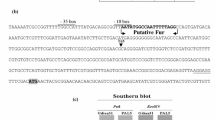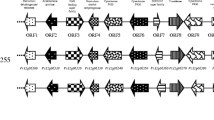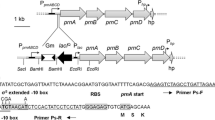Abstract
Burkholderia glumae synthesizes toxoflavin, a phytotoxin that contributes the virulence of this phytopathogen. The toxoflavin biosynthetic gene cluster contains a tox operon composed of five genes, toxABCDE, and toxB is predicted to encode a GTP cyclohydrolase II, which is the first enzyme (RibA) in riboflavin biosynthesis. ToxE is also homologous to RibD, the bifunctional deaminase/reductase acting on the RibA product. This suggests that toxoflavin and riboflavin biosynthesis share the first two steps in their respective biosyntheses. In this study, we demonstrated that ToxB and B. glumae RibA (Bglu-RibA) both displayed GTP cyclohydrolase II activity with comparable kinetic parameters. When toxB was inactivated, toxoflavin production was abolished, and introduction of a plasmid copy of Bglu-ribA restored toxoflavin production in a ΔtoxB mutant. ToxB and Bglu-RibA can thus be defined as GTP cyclohydrolase II isozymes, even though Bglu-ribA is not a genetic equivalent of toxB because the chromosomal copy of Bglu-ribA is unable to support toxoflavin production in the absence of toxB. In LB agar culture, toxAB is incapable of complementing ΔtoxB though toxABC induced toxoflavin accumulation in the ΔtoxB mutant up to 80 % of the WT level. This indicates that toxBC co-expression is a critical factor for toxoflavin biosynthesis in this condition, suggesting that the WD repeat protein ToxC acts as a scaffolding protein in a toxoflavin biosynthetic metabolon. In LB liquid culture, toxAB successfully restored toxoflavin production, suggesting that a role of toxBC co-expression is dependent upon growth condition.





Similar content being viewed by others
References
Blair LM, Sperry J (2013) Natural products containing a nitrogen-nitrogen bond. J Nat Prod 76:794–812
Chen R, Barphagha IK, Karki HS, Ham JH (2012) Dissection of quorum-sensing genes in Burkholderia glumae reveals non-canonical regulation and the new regulatory gene tofM for toxoflavin production. PLoS ONE 7:e52150
Choi G, Lee J, Ji JY, Woo J, Kang NS, Cho SY, Kim HR, Ha JD, Han SY (2013) Discovery of a potent small molecule SIRT1/2 inhibitor with anticancer effects. Int J Oncol 43:1205–1211
DeShazer D, Waag DM, Fritz DL, Woods DE (2001) Identification of a Burkholderia mallei polysaccharide gene cluster by subtractive hybridization and demonstration that the encoded capsule is an essential virulence determinant. Microb Pathogen 30:253–269
Fischer M, Bacher A (2005) Biosynthesis of flavocoenzymes. Nat Prod Rep 22:324–350
Frelin O, Huang L, Hasnain G, Jeffryes JG, Ziemak MJ, Rocca JR, Wang B, Rice J, Roje S, Yurgel SN, Gregory JF 3rd, Edison AS, Henry CS, de Crécy-Lagard V, Hanson AD (2015) A directed-overflow and damage-control N-glycosidase in riboflavin biosynthesis. Biochem J 466:137–145
Gräwert T, Fischer M, Bacher A (2013) Structures and reaction mechanisms of GTP cyclohydrolases. IUBMB Life 65:310–322
Grill S, Yamaguchi H, Wagner H, Zwahlen L, Kusch U, Mack M (2007) Identification and characterization of two Streptomyces davawensis riboflavin biosynthesis gene clusters. Arch Microbiol 188:377–387
Kim J, Kim JG, Kang Y, Jang JY, Jog GJ, Lim JY, Kim S, Suga H, Nagamatsy T, Hwang I (2004) Quorum sensing and the LysR-type transcriptional activator ToxR regulate toxoflavin biosynthesis and transport in Burkholderia glumae. Mol Microbiol 54:921–934
Kim J, Oh J, Choi O, Kang Y, Kim H, Goo E, Ma J, Nagamatsu T, Moon JS, Hwang I (2009) Biochemical evidence for ToxR and ToxJ binding to the tox operons of Burkholderia glumae and mutational analysis of ToxR. J Bacteriol 191:4870–4878
Kim MS, Kim H, Moon JS, Hwang I, Joung H, Jeon JH (2012) Toxoflavin lyase enzyme as a marker for selecting potato plant transformants. Biosci Biotechnol Biochem 76:2354–2356
Kovach ME, Elzer PH, Hill DS, Robertson GT, Farris MA, Roop RM, Peterson KM (1995) Four new derivatives of the broad-host-range cloning vector pBBR1MCS, carrying different antibiotic-resistance cassettes. Gene 166:175–176
Levenberg B, Kaczmarek DK (1966) Enzymic release of carbon atom 8 from guanosine triphosphate, an early reaction in the conversion of purines to pteridines. Biochim Biophys Acta 117:272–275
Levenberg B, Linton SN (1966) On the biosynthesis of toxoflavin, an azapteridine antibiotic produced by Pseudomonas cocovenenans. J Biol Chem 241:846–852
Machlowitz RA, Fisher WP, McKay BS, Tytell AA, Charney J (1954) Xanthothricin, a new antibiotic. Antibiot Chemother 4:259–261
Magalhães ML, Argyrou A, Cahill SM, Blanchard JS (2008) Kinetic and mechanistic analysis of the Escherichia coli ribD-encoded bifunctional deaminase-reductase involved in riboflavin biosynthesis. Biochemistry 47:6499–6507
Miller WG, Leveau JH, Lindow SE (2000) Improved gfp and inaZ broad-host-range promoter-probe vectors. Mol Plant Microbe Interact 13:1243–1250
Nagamatsu T, Yamasaki H (2001) General syntheses of 1-alkyltoxoflavin and 8-alkylfervenulin derivatives of biological significance by the regioselective alkylation of reumycin derivatives and the rates of transalkylation from 1-alkyltoxoflavins into nucleophiles. J Chem Soc Perkin Trans 1(2):130–137
Philmus B, Shaffer B, Kidarsa T, Yan Q, Raaijmakers J, Begley T, Loper J (2015) Investigations into the biosynthesis, regulation and self-resistance of toxoflavin in Pseudomonas protegens Pf-5. ChemBioChem 16:1782–1790
Ren J, Kotaka M, Lockyer M, Lamb HK, Hawkins AR, Stammers DK (2005) GTP cyclohydrolase II structure and mechanism. J Biol Chem 280:36912–36919
Ritz H, Schramek N, Bracher A, Herz S, Eisenreich W, Richter G, Bacher A (2001) Biosynthesis of riboflavin: studies on the mechanism of GTP cyclohydrolase II. J Biol Chem 276:22273–22277
Sato Z, Koiso Y, Iwasaki S, Matsuda L, Shirata A (1989) Toxins produced by Pseudomonas glumae. Ann Phytopathol Soc Jpn 55:353–356
Schramek N, Bracher A, Bacher A (2001) Biosynthesis of riboflavin. Single turnover kinetic analysis of GTP cyclohydrolase II. J Biol Chem 276:44157–44162
Simon R, Prifer U, Puhler A (1983) A broad range mobilization system for in vivo genetic engineering: transposon mutagenesis in Gram-negative bacteria. Biotechnology 1:784–791
Spoonamore JE, Dahlgran AL, Jacobsen NE, Bandarian V (2006) Evolution of new function in the GTP cyclohydrolase II proteins of Streptomyces coelicolor. Biochemistry 45:12144–12155
Stirnimann CU, Petsalaki E, Russell RB, Müller CW (2010) WD40 proteins propel cellular networks. Trends Biochem Sci 35:565–574
Suzuki F, Sawada H, Azegami K, Tsuchiya K (2004) Molecular characterization of the tox operon involved in toxoflavin biosynthesis of Burkholderia glumae. J Gen Plant Pathol 70:97–107
Um HY, Chung E, Lee JH, Lee SW (2011) Improved antibiotic resistance gene cassette for marker exchange mutagenesis in Ralstonia solanacearum and Burkholderia species. J Microbiol 49:305–308
Yoneyama K, Kono Y, Yamaguchi I, Horikoshi M, Hirooka T (1998) Toxoflavin is an essential factor for virulence of Burkholderia glumae causing rice seedling rot disease. Ann Phytopathol Soc Jpn 64:91–96
Acknowledgments
This work was supported by 2015 Research Fund of Myongji University.
Author information
Authors and Affiliations
Corresponding author
Rights and permissions
About this article
Cite this article
Joo, M., Yoo, HG., Kim, HJ. et al. ToxB encodes a canonical GTP cyclohydrolase II in toxoflavin biosynthesis and ribA expression restored toxoflavin production in a ΔtoxB mutant. J Korean Soc Appl Biol Chem 58, 877–885 (2015). https://doi.org/10.1007/s13765-015-0116-9
Received:
Accepted:
Published:
Issue Date:
DOI: https://doi.org/10.1007/s13765-015-0116-9




